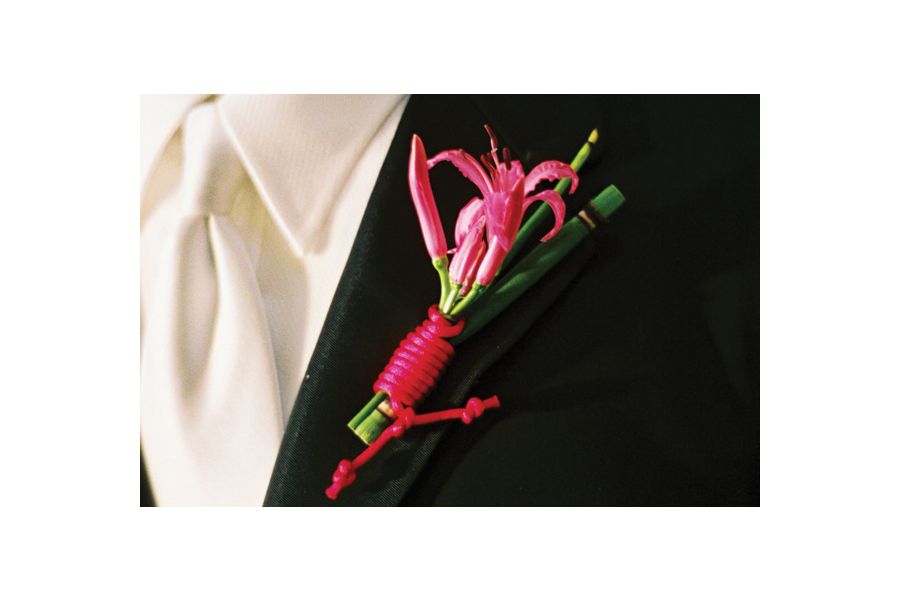Wedding Blooms for the Groom

When I got married, I actually spent more time thinking about my husband’s boutonniere than I did about my own bouquet. I wanted him to actually like it, and, quite honestly, his boutonniere was going to be in far more pictures than any blossoms I’d be holding. Happily, both boutonniere and bouquet were a great success, thanks to my fabulously creative florist, Janis Steinfeld, owner of August Gardens in Hillsboro, Ore. It was she who taught me a thing or two about how to choose the right bloom to pin on my groom.
To begin, for a look that’s both cohesive and cost-effective, Steinfeld always suggests matching the groom’s boutonniere to the bridal bouquet. Roses and other popular choices such as calla lilies or freesia are ideal for boutonnieres as they have the lasting power for hours spent on a lapel and the durability to withstand multiple hugs.
On Steinfeld’s best-to-avoid list are: flowers with distractingly large heads, like dahlias; hydrangeas, especially during the summer months as they wilt rapidly in the heat; white roses, which tend to turn brown far too quickly; and tulips, as they invariably open up to the size of a saucer by the time the groom can say “I do.” “And we never, never, never use baby’s breath unless we risk losing the wedding, and even then it’s only under great duress,” says Steinfeld, speaking to her own personal taste.
But beyond that, the garden’s the limit when it comes to both eye-catching and frill-free boutonnieres. Many of Steinfeld’s most unique pieces have incorporated simple and sublimely scented organic herbs, such as sage, rosemary and fresh lavender which she grew herself in her own backyard, as well as shapely greens such as Israeli ruscus, lily grass or dusty miller.
Unusual greens, such as the velvety, silver-hued Lamb’s Ear or the colorful, oak leaf-shaped foliage of a scented geranium, also are a favorite of Maggi Whitaker, owner of Down to Earth Flowers & Gifts in Snoqualmie, Wash. For a wedding show, she created a stunning boutonniere using the unfurled fronds of the Fiddlehead Fern. One of the spirals pointed up and one pointed down, with a green, pod-like berzillia in the center.
Since then, the Dr. Seuss-ish fern fronds have appeared in many of her boutonnieres and bouquets. “They’re both whimsical and geometric,” Whitaker says. “Guys like them because they’re less fluffy, but they look really nice when paired with gorgeous, structured flowers like orchids or calla lilies.”
Whitaker also finds that men tend to like Leucadendron, an evergreen shrub with spirals of long, petal like leaves that comes in shades of burgundy, yellow or green, which can look flowery without being a blossom.
Another popular selection, the star-shaped Stephanotis, is actually a flower, but the small, waxy structure makes it more masculine-friendly. And then, of course, there are simple, colorful, spherical berries, such as hypericum or even unripe blackberries, which look lovely either alone or with flowers.
But if you do decide to go for a boutonniere entirely made of greens and you feel like it needs more of a tie-in to the rest of your décor, you can wrap the stem in ribbon or bullion wire that approximates one of your wedding colors, suggests Whitaker. Bullion is a thin wire that comes in gold, silver, copper or vibrant colors like apple or dark green, bright or pale pink, purple, red, blue or even turquoise.
Or maybe, just maybe, you’ll find yourself with a groom who’d rather not blend in with the bushes. “I once did a boutonniere that was just a giant, yellow sunflower that looked a bit like a lit street lamp,” says Steinfeld. “It ended up being the highlight of the evening and the